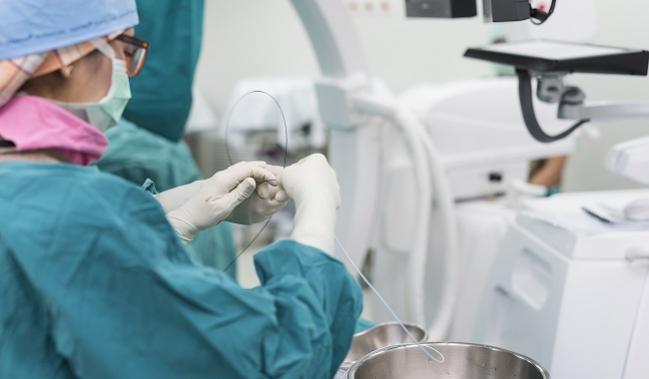Positionable Shields Slash Radiation Exposure to Cath Lab Staff by Two-Thirds
The findings may be particularly relevant for nurse circulators, who spend more cumulative time in procedures than physicians do.

Having nurses and technologists work behind lead shields in the cath lab slashes their radiation exposure by more than 60%, researchers say.
“When you have a simple and inexpensive thing that you can do on the job to cut your radiation exposure by two-thirds, I don’t see a down side of that,” lead study author Ryan D. Madder, MD (Frederik Meijer Heart & Vascular Institute, Grand Rapids, MI), told TCTMD. “Once we had our data, our organization purchased [shields] for every cath lab.”
The shields used in the study are relatively inexpensive compared with the capital cost of other equipment in cath labs and can be reused indefinitely. Although operators naturally have higher total exposure to radiation during procedures than nurses or other staff, the study findings are important in light of the fact that nurses are often the only people on the cath lab team who are there for every case, every day of the week.
“When you look at their cumulative dose over time compared with some other roles in the cath lab, including the physician, they may actually be getting more radiation exposure . . . and that ups the stakes for nurses,” Madder said.
Shielding Works
For the SHIELD study, published online November 1, 2017, in JACC: Cardiovascular Interventions, Madder and colleagues used dosimeters to collect real-time radiation exposure data from nurse circulators and scrub technologists during 764 consecutive catheterizations performed between August 2015 and February 2016. The study was divided into two parts, comparing radiation dose with standard lead protection (skirt, apron, and thyroid collar) before and after the addition of routine use of the accessory shields.
Once we had our data, our organization purchased [shields] for every cath lab. Ryan D. Madder
The radiation shields tested in the study consist of a portable leaded glass barrier that is approximately 6 feet tall, 2.25 feet wide, and 0.5 mm thick. For nurse circulators, the shield was positioned between the patient and the IV pole. For scrub technologists, it was placed near the foot of the table so they could stand behind the shield whenever possible, including when performing injections with contrast. Radiation-absorbing disposable pads (RadPad, Worldwide Innovations & Technologies, Kansas City, MO) were also used in some, but not all, procedures (59%).
Overall, technologists saw a 62.5% decrease in effective dose normalized to dose area product after using the shielding device, while the decrease for nurses was 63.6%. Even more startling, the study also found when procedures involved PCI or fractional flow reserve (FFR) measurement, the radiation dose to nurses increased by 112% and 41.9%, respectively, even after multivariable analyses, compared with non-PCI or non-FFR procedures. Madder said the findings highlight the importance of shielding nurses to combat the additional radiation exposure of those procedures; they suggest that giving medications and performing other duties probably explain the increase in their exposure because they are in closer proximity to the patient and the radiation source.
Data Changed Behavior
Stacie Garcia-Moon, RN, BSN, a nurse circulator who participated in the study, said once she saw the results, using the shields became a priority. Each weighs about 60 pounds and is on wheels for easy positioning.
“It was definitely something that I had to remember to put in place each time I set up the room, but it didn’t take long to get used to it,” she told TCTMD. “We use this routinely now, and when a staff member doesn’t remember we make it a point to say, ‘Hey, where’s the shield?’ But it’s been months now, and everyone pretty much consistently uses the shield in our cath labs. The data changed people’s behavior and made them take their health a little more seriously.”
Madder added that they have continued to monitor radiation exposure among their staff since the study ended and have consistently seen decreases with use of the shields.
“All interventional cardiology labs should be equipped with these shields to support comprehensive radiation safety practices,” say Kenneth A. Fetterly, PhD, and Malcom R. Bell, MD (both Mayo Clinic, Rochester, MN), in an editorial accompanying the study.
They add that the substantial increase in radiation exposure seen with PCI and FFR “should serve to remind cardiac catheterization workers to be aware of their proximity to radiation in relation to their patient-care duties and remind physicians to be cognizant of safe radiation practice, including awareness of the position and proximity of their coworkers whenever they are using fluoroscopy.”
Madder agreed, adding that the entire team needs to be empowered to speak up.
“We’ve put a lot of work into [ensuring] that the entire team in our cath lab is being more vocal when a nurse is approaching the table so that the physician gets off the pedal,” he said. “Of course there are emergent situations where maybe that’s not possible, but in the majority of instances it is the right thing to do to allow the nurse to attend to the patient and then get out before resuming fluoroscopy or cineangiography.”
L.A. McKeown is a Senior Medical Journalist for TCTMD, the Section Editor of CV Team Forum, and Senior Medical…
Read Full BioSources
Madder RD, LaCombe A, VanOosterhout S, et al. Radiation exposure among scrub technologists and nurse circulators during cardiac catheterization: the impact of accessory lead shields. J Am Coll Cardiol Intv. 2017;Epub ahead of print.
Fetterly KA, Bell MR. Routine use of accessory lead shields is a very reasonable approach to enhancing radiation safety in the cardiac catheterization laboratory. J Am Coll Cardiol Intv. 2017;Epub ahead of print.
Disclosures
- Madder reports research support from and serving on the advisory board of Corindus Vascular Robotics.
- Fetterly and Bell report no relevant conflicts of interest.


Comments